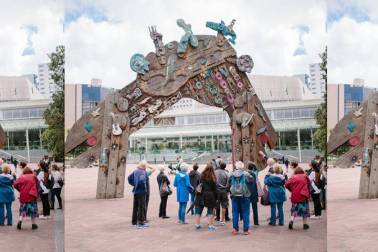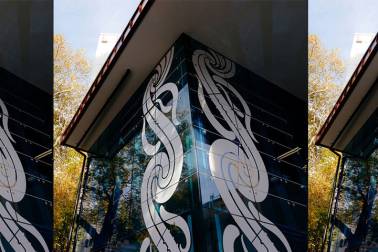For over fifty years and in many forms, Te Wiki O Te Reo/Mahuru Māori has been celebrated by Aucklanders and the 2024 program will carry on that tradition. What began as a call for recognition and revitalisation of Te Reo Māori by representatives of Ngā Tamatoa, Victoria University's Te Reo Māori Society, and the New Zealand Māori Students Association in the form of a petition with over 30,000 signatures back in 1972, evolved into Māori Language Day and later, Te Wiki O Te Reo/Mahuru Māori.
Today, we celebrate Te Wiki O Te Reo/Mahuru Māori, a month of celebrations of Māori language and culture, giving Aucklanders the opportunity to engage with, see and hear Te Reo Māori across the city.
An extensive program has been put together this year to help Aucklanders to do just that. Explore movies, workshops, author talks, discussions, light installations and more in the city this year to get involved, no matter your level of Te Reo Māori!
Exhibitions & Art Installations
Waiwaia Ngā Ngutu Exhibition
Check out Auckland Libraries’ newest exhibition, Waiwaia Ngā Ngutu from Wednesday 4th September - 1st February, that focuses on showcasing Te Reo Māori and exploring the richness of the language through the taonga from Auckland Libraries Heritage Collections.
Te Reo - Neon Art on Lorne Street
Brighten up your day with a visit to one of the Te Reo-inspired art installations happening in the city centre! From Monday 2nd September to Wednesday 30th October, you can spot the eye-catching neon art pieces created by Ataahua Papa (Ngāti Korokī Kahukura, Ngāti Mahuta), and Angus Muir Design lighting up Lorne Street.
Taurima - Neon Art on Elliott Street West
Wander down Elliott Street West this month to take in the crochet-like neon spectacular artworks inspired by the street’s 500-year culinary history! Read about the story in detail in English and Reo on the story plinth on Darby while taking in the work of artists like Lissy Robinson-Cole (Ngāti Kahu and Ngāti Hine) and Rudi Robinson-Cole (Waikato, Ngaruahine, Ngāti Pāoa, Te Arawa).
Te Reo Māori & Photography Poster Wall at Central City Library
From Sunday 15th September to Sunday 29th September, you can find a series of whakataukī (sayings), poems in Te Reo Māori and English and song lyrics with photography will be on display along the wall opposite Central City Library. Look out for Hone Tuwhare’s poem “He motu te awa He awa koe” (The river is an island) that will feature alongside an image from Te Maharatanga o Ngā Wai (remembering our Waters). It is a pocket park on the corner of Victoria Street West and Sale Street where te reo can be seen, read, heard, and spoken through a QR code.
Whai – Light Installation
For all of September, you can enjoy the bright lights of Whai in Victoria St Car Park, an art installation that connects the stories handed down through the generations to the creativity and innovation of current times. Follow Janine Williams, a descendant of Ngāti Whātua ki Kaipara and Ngāti Paoa, as she tells her story of her journey of learning and reclaiming the language.
Te Hopu a Māui i a te Rā - How Maui Slowed the Sun by Peter Gossage at Central City Library
One of the most popular books in Aotearoa, 'The story of How Maui Slowed the Sun' in Te Reo Māori and English has been recreated in a huge 1.5m by 1. Scale, bringing the stunning illustrations and story to life.
Readings, Talks & Conversation Opportunities
Tales and Travels: Māori history in Tāmaki Makaurau at Central City Library
On Monday 9th of September from 10am to 11am, there’s an opportunity to learn more about the important moments in Māori history here in Tāmaki Makaurau in a reading club in Central City Library. Learn about the wider community, culture and experiences through the many books and library resources that examines memories, experiences and conversation.
Kupurori (Māori Scrabble) with Lifewise at Central City Library
On Thursday 12th, 19th and 26th of September from 10am to 12pm join in the fun with Kupurori! A project designed by our whānau, for whānau, and prototyped by the Merge Community team, Kupurori is more than your usual scrabble – it’s played in te reo using a giant board and giant retu! A fun and relaxed way to get involved and brush up on your language skills.
Tōku reo tōku ohooho – A migrant’s transformation journey of learning te reo at Central City Library
Get inspired on Friday 20th of September from 2pm to 3pm and come along to listen to Lidu Gong, an educator and senior librarian from Te Wānanga o Aotearoa, share his te reo learning methods and transformative experience. Learning te reo at 57 years old and becoming a fluent speaker, his journey will inspire you to start your own te reo learning journey, regardless of your age!
Tales and Travels: A journey around Aotearoa
On Tuesday 24th of September from 10am to 11am, join this reading club as they travel from Otou to Motupo-hue using books, library resources and memories of our own experiences and knowledge of the Aotearoa landscape. This reading club looks at utilising memory recall to keep their minds working while learning about their community.
Proudly supported by Auckland Council and the city centre targeted rate.



